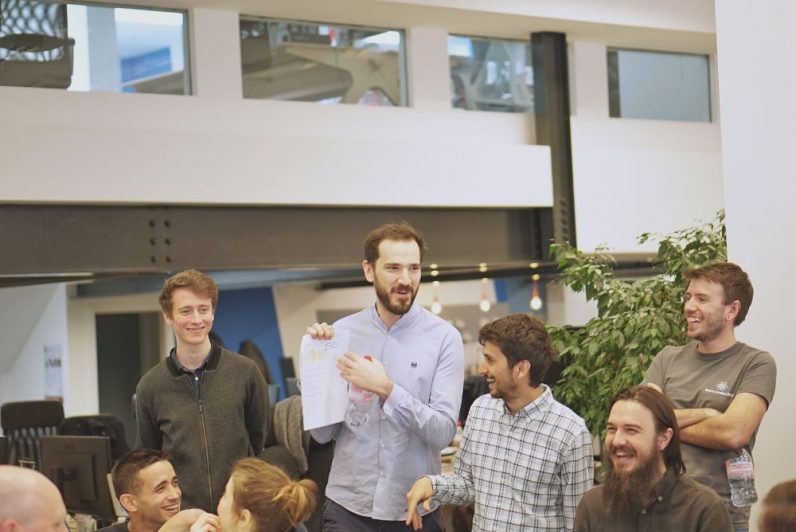In your company’s growth journey, it’s important to take the time to assess its progress, mission, and direction. This should happen quarterly, as short-term goals can often become the focus of decision making and take away energy from your main objectives. On our team, we’ve found that a quarterly all hands meeting can keep your company focused on making meaningful, long-term progress. In this blog post, I’ll share with you what we’ve found to work best.

At Pusher, we run a quarterly three-day session with everyone in the company. The time spent together on evaluating our activities helps our team to grow and build a shared understanding of our mission. It pushes us to break down silos and structure our plans for improvement.
As the CEO, this is one of the areas I most enjoy being involved in. As we all take the time to reflect on our progress, we can connect with each other and align our goals for the next quarter. Our all hands meetings have become a ritual for us and they’re part of our organizational heartbeat.
I believe there are five reasons why any growing SaaS company needs to have a quarterly all hands meeting:
1. To Establish a Shared Mission
One of the primary aims of a quarterly all hands meeting is to refocus and reinforce the company mission; in our case, to empower developers to build great software so they can change the world for billions of people. Various aspects of our mission are available on our website, on our wiki, and in our onboarding sessions. However, as the company scales and we’re hiring new people, it’s important that everyone knows the mission and hears about it from the executive team firsthand.
By having a shared understanding of our goals, we can allow people to work autonomously by aligning their work with our company values. We balance autonomy and accountability in our employees’ daily work by measuring our progress against our quarterly objectives and by providing consistent feedback. When people find meaning in their work they also find a sense of ownership, according to HBR. Therefore, every quarterly all hands meeting is an opportunity to look into the future and position ourselves on our historical trajectory.
Productive Product Management
Discover MeisterTask2. To Deconstruct Inefficiencies
As well as building a shared model, we are also constantly trying to fight against inefficiency and lack of effectiveness.
We’ve found there are 3 main areas where inefficiency starts to creep in over time:
- People forget the mission (related to point one) or form their own ideas of the mission, extrapolating things that aren’t there.
- Processes get sloppier: by not doing things we should be doing, or by wasting time doing things we shouldn’t instead. For example, if our quarterly focus is exploring new customer pipelines, then we should be avoiding time spent on reiterating old marketing strategies.
- People lose energy: their morale falls or they question what others are doing.
The quarterly all hands meeting is an opportunity to pick ourselves up on these points, through team retrospectives. Each quarterly all hands meeting at Pusher has a theme and this helps us actively review what we have achieved during each quarter. This includes assessing which strategies worked and where to go next. Although we hold separate sessions for each department, most discussions are cross-departmental as we solve current challenges and establish processes to address them.
3. To Constantly Improve
In addition to finding a common understanding of our goals and preventing bad habits from forming, the route to success is built on constant improvement of everything we’re doing. This means everything from product development to making sure that we’re all aligned with our company values. Operational excellence doesn’t spring from anywhere.
We emphasize this through an anonymous internal survey, which we send at the end of each quarterly all hands meeting. In the survey, we ask for feedback on each session and we apply that learning to improve our processes. This helps us discover what we are doing well and how we need to improve our company culture. It’s a process of acknowledging mistakes and being willing to make changes.
4. To Evaluate Your Activity
In our quarterly all hands meeting, we aim to demonstrate our company’s values of trust and accountability by being transparent about its functioning. This is essential for creating a culture where SaaS companies can be successful, so our management team tries to be open about our organizational shortcomings, and our outputs.
We also demonstrate accountability by reviewing our previous objectives and evaluating whether we’ve lived up to them. This can include reviewing our sales and marketing results, progress in product development, hiring stats and progress of our work in the diversity committee. We also make sure that everyone in the company receives an update on our financial situation. That’s why we view each quarterly all hands meeting as a link in a chain of constant improvement, rather than seeing it in isolation.
5. To Break Down Silos
The final reason for holding our quarterly get-together is about our people. For me, this is the most important point. As any organization gets larger it becomes harder to maintain good working relationships between colleagues and understand how they are contributing to its mission.
While operating in departmental silos is often a necessary evil, as it reduces the amount of context employees need for their day-to-day work, it’s equally important to make sure that communication lines remain open. Smashing the silos is a good way to avoid a lack of information flow, enabling a more coordinated decision-making workflow.
The central day of our quarterly all hands meeting is an opportunity for team members to work with colleagues they wouldn’t normally interact with. It provides a chance to have fun, exchange ideas, and hopefully form links that strengthen our company network as a whole.
For example, we make sure that our sales and marketing teams work together to map common projects for the upcoming quarter. These could mean creating commercial videos or case studies with our clients, optimizing our website, or making sure we test the right messages with the right stakeholders.
Importantly, this day is also about having fun together. We always plan a social evening for the whole company and aim to let people get to know each other outside of our daily work.
Seeing the Bigger Picture
A quarterly all hands meeting is a great opportunity to solidify your company’s culture. As your company grows, the quarterly review process will change to accommodate its needs.
Ultimately, it’s all about employees understanding the direction of the company and how they fit into the bigger picture.
I hope some of these tactics we use at Pusher will help you to think about how you can inspire your employees to feel connected to your company mission, and its overall growth trajectory, with a quarterly all hands meeting.
Max Williams, Founder and CEO of Pusher
Product management, simplified
Discover MeisterTask


